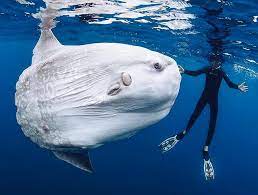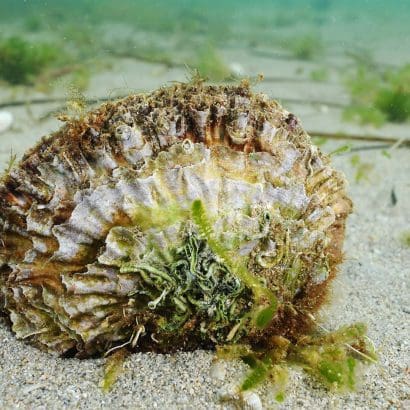
The sunfish, also known as the mola mola, is a unique fish species. It is the largest bony fish in the world, with an average weight of 1000 kg and a length of up to 3 meters. In addition to its impressive size, the sunfish is known for its distinctive appearance, with a flattened and rounded body and a head that seems to have no neck.
This fish inhabits tropical and temperate waters worldwide and is known for its jellyfish-based diet, which constitutes the majority of its food. Despite its unusual size and appearance, the sunfish is harmless to humans and is of interest to scientific research due to its unique characteristics and role in the marine ecosystem. In this topic, we will delve into the most interesting curiosities and details about the sunfish and its jellyfish-based diet.
Contents
Origin of the Sunfish.🐟
The origin of the sunfish, also known as the mola mola, can be traced back to the Oligocene epoch, approximately 30 million years ago. Fossil evidence indicates that the sunfish evolved from a group of spiny-finned fish called the Tetraodontiformes, which also includes pufferfish, triggerfish, and boxfish.
Over time, the sunfish developed a unique set of adaptations to its environment, including its flattened body shape, which allows it to maneuver more easily through the water and conserve energy. Its large size and unique shape also provide it with a number of defense mechanisms against predators, such as its ability to swim in a vertical position to present a smaller profile to its enemies.
Despite its ancient origins, the sunfish remains a fascinating and mysterious creature to this day, with much still unknown about its behavior and biology. However, ongoing research efforts are shedding new light on this enigmatic fish, helping to further our understanding of its unique place in the marine ecosystem.
Physical characteristics of the Sunfish.🐟
The sunfish, or mola mola, is a fish species with a unique and distinct physical appearance. It is the largest bony fish in the world, with a flattened and circular body that can reach up to 3 meters in length and weigh up to 2,000 kg.
The sunfish has a distinctive appearance, with a roundish, almost disc-shaped body that is compressed laterally. The head of the sunfish is small and blunt with a small mouth, and there is no visible tail fin, just a small dorsal and anal fin. Its skin is thick and rough, covered in a layer of mucus that protects it from parasites and infections.
The sunfish is also known for its unique coloration. The upper body of the fish is a dark olive green to grayish-brown color, while the lower body is a lighter color, often white or silver. The sunfish has a few protruding bumps or ridges on its skin, which give it a rough texture.
The sunfish has some peculiar habits too, as it has a preference for swimming vertically with its dorsal fin emerging from the water, resembling a floating island. It is also known to sunbathe at the water surface to warm itself and relieve its skin of parasites.
Sunfish Feeding Habits.🐟
The sunfish, or mola mola, has a unique and specialized diet consisting mainly of jellyfish and other gelatinous zooplankton. This fish species consumes vast amounts of these organisms, with an adult sunfish capable of consuming up to 60 pounds (27 kg) of food in a single day.
One reason for the sunfish’s preference for jellyfish is that they are plentiful in the ocean, and the sunfish has a high metabolism that requires a lot of food to sustain its large size. Another reason is that jellyfish are relatively low in nutrients, meaning the sunfish must consume a large volume of them to meet its nutritional needs. The sunfish also has a specialized digestive system that allows it to break down the tough and fibrous tissues of the jellyfish with ease.
Despite its preference for jellyfish, the sunfish has been known to consume other types of food as well, including small fish, crustaceans, and squid. However, these make up only a small part of the sunfish’s overall diet.
Sunfish Curiosities.🐟
The sunfish, or mola mola, is a unique and fascinating creature that has many interesting characteristics and behaviors. Here are some of the most intriguing curiosities of the sunfish:
Size:
The sunfish is the largest bony fish in the world, with a length of up to 3 meters and a weight of up to 2,000 kg.
Appearance:
The sunfish has a unique and distinct appearance, with a flattened and circular body that lacks a tail fin, and a small head with a small mouth.
Diet:
The sunfish’s specialized diet consists mainly of jellyfish and other gelatinous zooplankton, with an adult sunfish capable of consuming up to 60 pounds (27 kg) of food in a single day.
Sunbathing:
Sunfish are known to float on their sides at the water surface to warm themselves in the sun and remove parasites from their skin.
Parasite cleaning:
Sunfish are often accompanied by schools of smaller fish that feed on the parasites that live on the sunfish’s skin.
Endangered species:
The sunfish is considered a vulnerable species, primarily due to its slow reproductive rate, large size, and susceptibility to fishing gear.
Mola festivals:
In some regions of the world, such as Bali and Japan, the sunfish is celebrated with festivals and art exhibitions.
👀If you want to learn about other strange fish species, I invite you to read our article Discover Deep-Sea Fish.
Threats and Conservation Methods for the Sunfish.
Despite its unique characteristics, the sunfish faces a number of threats that have put its population at risk. Here are some of the main threats to the sunfish and the methods used to conserve this species:
- Overfishing: Sunfish are frequently caught as bycatch in commercial fishing operations, and their meat is considered a delicacy in some parts of the world. To address this issue, regulations have been put in place to limit the amount of sunfish that can be caught and to ban the sale of their meat.
- Habitat loss: Sunfish are highly migratory and require large areas of open water to feed and reproduce. The construction of dams and other human-made structures can disrupt their migratory patterns and fragment their habitat. To mitigate this threat, conservationists are working to protect and restore the sunfish’s natural habitat.
- Pollution: Sunfish are susceptible to pollution from plastic debris, oil spills, and other contaminants. Efforts to reduce pollution and clean up affected areas can help protect the sunfish and other marine species.
- Climate change: Rising temperatures and ocean acidification caused by climate change can alter the distribution and abundance of the sunfish’s food sources, potentially leading to population declines. Conservationists are working to reduce greenhouse gas emissions and protect the sunfish’s habitats from the impacts of climate change.

Conservation efforts for the sunfish include monitoring and research programs, protected areas, and international agreements such as the Convention on Migratory Species and the International Union for Conservation of Nature. By addressing these threats and implementing effective conservation measures, we can ensure the survival of this unique and fascinating species for generations to come.


